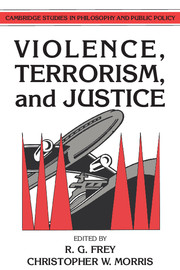Book contents
- Frontmatter
- Contents
- List of contributors
- Preface
- 1 Violence, terrorism, and justice
- 2 What purposes can “international terrorism” serve?
- 3 Violent demonstrations
- 4 Terrorism, rights, and political goals
- 5 The political significance of terrorism
- 6 Terrorism and morality
- 7 Which are the offers you can't refuse?
- 8 Making exceptions without abandoning the principle: or how a Kantian might think about terrorism
- 9 State and private; Red and White
- 10 State terrorism
- 11 Nuclear hostages
- 12 Rape as a terrorist institution
10 - State terrorism
Published online by Cambridge University Press: 05 June 2012
- Frontmatter
- Contents
- List of contributors
- Preface
- 1 Violence, terrorism, and justice
- 2 What purposes can “international terrorism” serve?
- 3 Violent demonstrations
- 4 Terrorism, rights, and political goals
- 5 The political significance of terrorism
- 6 Terrorism and morality
- 7 Which are the offers you can't refuse?
- 8 Making exceptions without abandoning the principle: or how a Kantian might think about terrorism
- 9 State and private; Red and White
- 10 State terrorism
- 11 Nuclear hostages
- 12 Rape as a terrorist institution
Summary
PART ONE: TERRORISM
“Our” cause is usually supported by the resistance, by the underground, or by freedom fighters, while “their” cause is often supported by terrorists. The use of the word “terrorism” is often so loose and so loaded that it is tempting to abandon it. Perhaps we would do better with more fine-grained concepts, distinguishing types of political violence on the basis of different aims, victims, methods, and use by different groups. But there are some common patterns, and perhaps they make the category of terrorism, if carefully used, worth retaining for some purposes.
It may be Procrustean to start with a very detailed account of the boundaries of terrorism. There is a case for starting with a rough-and-ready account, bearing in mind that it may need tightening up or modifying as we see which activities seem to cluster together.
The central feature of terrorism is political violence. Murders or armed robberies without political motive are not terrorism. The terrorist aims to further a political cause by using or threatening violence. And the violence is not directed merely against property. People are killed, or subjected to kidnapping, hijacking, wounding, or other severe ill-treatment. Or there is an attempt to coerce people by the threat of these things. The violence or the threats have to be of the kind that can strike terror into people.
- Type
- Chapter
- Information
- Violence, Terrorism, and Justice , pp. 256 - 275Publisher: Cambridge University PressPrint publication year: 1991
- 6
- Cited by



